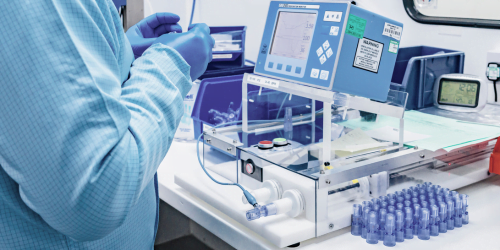Success for all Original Equipment Manufacturers (OEMs) – from the biggest corporations to the thousands of Medtech SMEs and start-ups – hinges on the ability to follow key design, testing, risk, validation and manufacturing principles. With approximately 600,000 medical devices on the UK market, what makes a good idea life changing? And when is the best time to fast track development to ensure you are first to market?
Designing and making a medical device is very much a collaborative effort. The mix of skills often comprises researchers, clinicians, product designers and manufacturers, each interjecting at various stages of the development cycle. Getting to market faster isn’t just about speed. It also requires a good amount of industry prowess, and knowing when to pull in the right expertise.
Europlaz’s Commercial Director, Rory O’Keeffe, identifies what to look for and what to be wary of when evaluating a reliable medical device manufacturer.
Fast tracking ideas
Innovation is inherently challenging. Invariably there will be months if not years of ideas being refined and hard work developing prototypes. But when a standout, life-enhancing product gets to market faster, the rewards – reputational and financial – can be huge.
Medical device contract manufacturers play a vital role in facilitating this transition from concept to market launch and scaling up production. In order to jump ahead of the competition, Rory highlights that partnering with specialists gives OEMs, innovators and design houses the edge in many aspects.
By providing access to a wider talent pool and cutting edge technologies that may not be available in-house, it can reduce risk and cost and help with scalability. “Drawing upon experienced contract manufacturers gives OEMs the freedom to focus on their respective engineering and product development skills.” As many testify, it also allows organisations to manage risks more effectively. Most notably, supply chain resilience as well as navigating the latest regulatory challenges.
Using a medical device manufacturer
Not all contract manufacturers are created equal. Some companies might be purely dedicated to making components. Others provide much more detailed input, sharing expertise, advising on design modifications and materials. For the partnership to really work, there needs to be this element of trust, collaboration and transparency.
“Collaborating with outsourcing partners who specialise in rapid prototyping, design optimisation, or regulatory submissions can accelerate the development and commercialisation process. This can be crucial in gaining a competitive edge in the ever-evolving devices market,” explains Rory.
A manufacturer’s understanding of the sustainability and governance landscape can also help to provide different interdisciplinary perspectives to OEMs. This is increasingly important given the focus on social value, product lifecycle footprints and the recyclability of materials and how these all increasingly link back to market positioning, notes Rory.
From seasoned OEMs at the largest Blue Chip pharma firms, to fledging MedTech start-ups, the design-to-manufacturing principles are equally applicable, attests Rory. Each developmental phase requires the same meticulous attention to detail:
Check Capabilities: Ask targeted questions and visit the facility. Delve into their expertise, equipment and production processes. Talk to different team members and request references. If agreements allow, ask about specific case study examples of projects that have utilised similar skills, processes and outputs to your requirements.
Tip: Note that CMOs that spread their business across multiple sectors – including consumer, industrial, construction and medical – are less likely to eat, sleep and breathe the certification and validation standards compared to a pure medical device CMO.
Fit for Purpose: The CapEx cost to create the manufacturing infrastructure can be high and take a lot of time to implement. A CMO with technical competences, cleanroom facilities, and regulatory and certification knowledge can take an idea and hit the ground running.
Tip: With so many device types, check that your CMO has relevant experience in the right categories. For example, they may know drug delivery devices inside out, but do they understand the nuances of manufacturing surgical equipment?
Hidden Costs: One of the major development roadblocks is when pricing structures haven’t been clearly defined. By virtue, a development lifecycle often includes various component designs and tooling iterations. A good timeline and budget plan can help ensure costs don’t escalate beyond the project budget and compromise its viability.
Tip: Transparency is vital. Request a full breakdown of costs, including details of additional charges and when these would be applied.
Scalability and Supply Chain Shocks: Competency and capabilities will likely inform your CMO selection. But also examine the unpredictable logistics risks that could potentially jeopardise production timelines, material sourcing, stock handling etc. How proactive is the CMO with their risk strategy? What buffers are in place to mitigate supply chain disruptions? Do they have production capacity to respond to an influx of additional orders?
Tip: Ask the CMO when they last felt a geopolitical or sourcing risk could have potentially disrupted their business and how they assured customers. How did they adapt, rebound and recover?
Rigorous Reporting: There are phases in the formative development lifecycle where product iterations come and go. However, once a device reaches the CMO, the use of formal validation steps and structured communication becomes imperative. An ISO management system tracks changes to help streamline the regulatory application process.
Tip: Do the prototyping design tools used by the CMO factor in defined parameters e.g. material, weight, dimensional constraints, performance criteria, tolerances etc. and are they able to simulate how devices will behave in real-world conditions?
Unlocking growth
In the 2024 MedTech study recently published by consulting firm Roland Berger, sourcing and procurement, as well as supply chain were cited by senior executives as two of the most important steps to unlock growth. For processors that are prioritising profitability over top line growth, outsourcing medical device manufacturing can be the most economic and viable option, claims Rory.
“Sourcing a reliable medical device manufacturer is critical for ensuring the success and scalability of innovative medical products. By partnering with specialised contract manufacturers, OEMs can leverage advanced expertise, reduce risks, and streamline their path to market. As the medical devices landscape continues to evolve, the importance of selecting a manufacturer that excels in quality, transparency, and adaptability cannot be overstated. With extensive experience and comprehensive capabilities, the right manufacturing partner can support MedTech companies in bringing their life-changing ideas to fruition,” ends Rory.
For more information about Europlaz as a medical device manufacturer please contact us today.





